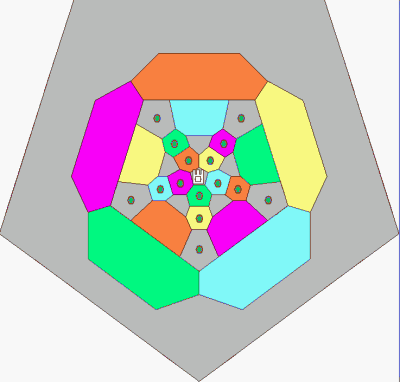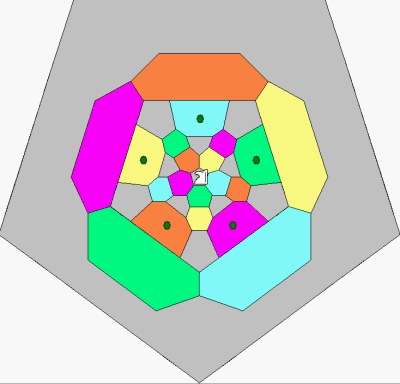Chess on a Soccer Ball
Chess on a Soccer Ball is, as its name suggests, a variant of Chess played on the surface of a soccer ball. Although I have seen other models, the standard soccer ball consists of 20 hexagons and 12 pentagons. I found designing this 32-cell variant very challenging, but also rewarding. I was able to adapt some pieces from FIDE chess to the geometry of the soccer ball (namely the Rook, Bishop, Knight, and Pawn), and also invented a few new pieces specifically for this game (namely the Wizard, Satellite, Ringmaster, and Guard, along with the "hidden" and "royal" versions of those pieces). I borrowed some ideas from Hexagonal Chess, Circular Chess, and even Klinzha to create this game.One of the greatest challenges was to find space on the 32-cell board for so many pieces! I solved it "stacking" the pieces: in the initial setup (see below), all of the pieces have Pawns or Guards on top of them. The Pawns or Guards must move off before the pieces can move. In the Zillions of Games program, do that by clicking on the cell where you want the Pawn or Guard to move. You cannot move a piece until the Pawn or Guard on top of it has moved off first.
The other great challenge was to represent the three-dimensional soccer ball on a two-dimensional surface, for the purpose of computer graphics. Borrowing a line from cartography, I opted for an Azimuthal Projection centred on a "pole", with distortion of distances further from the pole. In simple terms, this meant centring the ball on Pentagon A, cutting it open, flattening it out, and expanding all the cells around A. It's not very cosmetic, but it does the trick. If anybody with better graphic skills than mine wishes to improve the look of the board, please do so!
The King begins the game off-board. The first move of the game is to "crown" one of your other pieces, making it royal. In the Zillions of Games implementation, do that by clicking on the King (who occupies a dummy-cell off-board) and moving it on top of the piece of your choice.
Setup
Note : the term "hidden" indicates that the piece is topped by a Pawn (or, in the case of the Wizard, by a Guard).
Figure 1: showing the initial setup, with the kings off-board. The yellow and red pieces are really white and black pieces respectively, with pawns or guards on top of them.
WHITE: - Hidden Wizard - Pentagon L - Hidden Satellite - Hexagon z0 - Hidden Bishop - Hexagon z1 - Hidden Rook - Hexagon z2 - Hidden Knight - Hexagon z3 - Hidden Ringmaster - Hexagon z4 - King - off-board
BLACK: - Hidden Wizard - Pentagon A - Hidden Satellite - Hexagon x0 - Hidden Bishop - Hexagon x1 - Hidden Rook - Hexagon x2 - Hidden Knight - Hexagon x3 - Hidden Ringmaster - Hexagon x4 - King - off-board
Note: Zillions of Games does not allow multiple pieces on single cells, but I found a way to fool the program into thinking there is only one piece there: by treating each piece with its Pawn or Guard as a single piece, which splits into two pieces when the Pawn or Guard moves away.
Pieces
King - this piece is inspired by the Goal in Klinzha. The King, who begins the game off-board, has no movement powers of his own (except on the first move of the game) and must be carried by another piece. The first move of the game is, therefore, to move the King on top of the piece that will carry him. The Zillions version treats the King and the piece carrying him as a single piece. The Royal Rook, Royal Knight, Royal Bishop, Royal Ringmaster, Royal Satellite, and Royal Wizard are the resulting pieces. Each royal piece retains the movement capabilities of its simple form, but may not move into or through check.
Figure 2: showing how the King starts the game by choosing a piece (indicated by the green dots) to ride.

Figure 2a: Notice the crown above the yellow (white) Rook and red (black) Knight. White has chosen to have his King carried by the Rook, and Black by the Knight.

Rook - rides any number of cell along a straight path between two pentagons.
Figure 3: showing the Rook's paths away from a pentagon.

Bishop - rides in diagonal loops - defined as hexagonal cells connected by a line between two other cells. Players of many hexagonal chess variants will recognize this piece.
Figure 4: showing the Bishop's paths.

Wizard - rides in pentagonal loops - defined as pentagonal cells connected by a line between two hexagonal cells. The Wizard moves on pentagons much as the Bishop does on hexagons, and was inspired by the hexagonal bishop.
Figure 5: showing the Wizard's paths.

Knight - leaps (a) from one hexagon to another hexagon three cells away, (b) from a hexagon to a pentagon three cells away, or (c) from a pentagon to a hexagon three cells away.
Figure 6: showing the Knight's steps away from a hexagon.

Figure 7: showing the Knight's steps away from a pentagon.

Ringmaster - rides in hexagonal loops around a single pentagon. As each hexagon is adjacent to three pentagons, a Ringmaster may move in any one of three directions.
Figure 8: showing the Ringmaster's paths on hexagons around a pentagon.

Satellite - rides in crooked hexagonal loops around "equators", i.e., paths that divide the board equally in two. Each "equator" consists of ten hexagons and has five hexagons and six pentagons on either side of it.
Figure 9: showing the path of the Satellite.

Pawn - moves one cell without capturing on hexagons, or captures by moving one cell from a hexagon to a pentagon, on which it morphs into a Guard. The Pawn, unlike its FIDE counterpart, may move backwards or sideways as well as forwards. At the beginning of the game, every Pawn stands on top of another piece and must move off before that piece can move. The Pawn may not attack a royal piece (i.e., a piece carrying the King).
Figure 10: showing how the Pawn moves (green dots) and captures (red dots).

Guard - moves one cell without capturing on pentagons, or captures by moving one cell from a pentagon to a hexagon, on which it morphs into a Pawn. At the beginning of the game, the Guard stands on top of the Wizard, and must move off before the Wizard can move. The Guard may not attack a royal piece (i.e., a piece carrying the King).
Image 11 : showing how the guard moves (green dots) and captures (red dots).

Hidden pieces - pieces with Pawns or Guards on top of them, and are paralyzed until the Pawn or Guard moves off. N.B.: If you are playing Zillions, the yellow and red pieces in the initial setup are really white and black pieces, respectively, with Pawns or Guards on them. When the Pawn or Guard moves off, the piece left behind will change colour.
Royal pieces - ordinary pieces that are carrying a King. In Zillions, when the King mounts a piece, a crown appears above it.
Rules
1. The game begins by moving the King on top of the piece that will carry him. Any piece in the initial setup may be chosen.2. Next, start moving Pawns and Guards off pieces. In the Zillions implementation, you will get an error message if you try to move a piece with a Pawn or Guard on top of it - "Sorry, that piece cannot move now." Choose a piece, and click your mouse on the cell where you want the Pawn or Guard to move. It will move off, leaving the piece behind - which will change colour (yellow to white, red to black).
3. Pawns and Guards *may not* give check to a royal piece. You may well ask why not. When play-testing with Zillions of Games, I found that every game seemed to be like "fool's mate" in FIDE - every game lasted a mere 3-5 moves, with White winning every time. Frankly, I don't find "fool's mate" much fun - I like games to last a little while. I found the pawns were responsible for most of the premature checkmates, so I disabled their ability to attack royal pieces.
4. In the Chivalrous version, a royal piece may not attack another royal piece. In the default version, however, it may.
5. The game is won by checkmate, stalemate, or baring the enemy King.
Notes
 I have programmed a Zillions of Games file for this variant. You may download it here.
I have programmed a Zillions of Games file for this variant. You may download it here.
* Free distribution of this game is permitted - and, in fact, encouraged - for any noncommercial purpose.
* You have Zillions experience? Feel free to optimise the code, correct any bugs, create variants for this game, or even use ideas (including code) from this program in games of your own. You may email me
with suggestions. If I use your suggestions in future editions, I will acknowledge you. This 'user submitted' page is a collaboration between the posting user and the Chess Variant Pages. Registered contributors to the Chess Variant Pages have the ability to post their own works, subject to review and editing by the Chess Variant Pages Editorial Staff.
This 'user submitted' page is a collaboration between the posting user and the Chess Variant Pages. Registered contributors to the Chess Variant Pages have the ability to post their own works, subject to review and editing by the Chess Variant Pages Editorial Staff.
By David Cannon.
Web page created: 2009-02-22. Web page last updated: 2009-02-22
